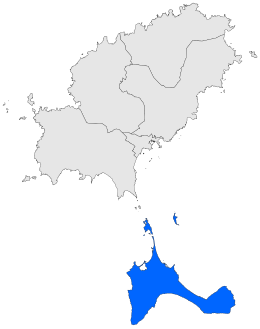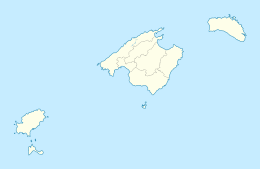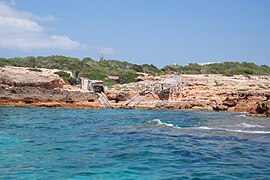geo.wikisort.org - Island
Formentera (Catalan pronunciation: [furmənˈteɾə], Spanish: [foɾmenˈteɾa]) is the smallest and most southerly island of the Pityusic Islands group (comprising Ibiza and Formentera, as well as various small islets), which belongs to the Balearic Islands autonomous community (Spain). It covers an area of 83.22 square kilometres (32.13 sq mi) (including offshore islets) and had a population of 10,582 at the Census of 1 November 2011; the latest official estimate (as at 1 January 2019) was 12,111.[1]
 Flag of Formentera | |
 | |
 Formentera | |
| Geography | |
|---|---|
| Location | Mediterranean Sea |
| Coordinates | 38°42′N 1°27′E |
| Archipelago | Pityuses, Balearic Islands |
| Area | 83.24 km2 (32.14 sq mi) |
| Highest elevation | 119 m (390 ft) |
| Highest point | La Mola |
| Administration | |
Spain | |
| Autonomous community | Balearic Islands |
| Largest settlement | Sant Francesc Xavier |
| Demographics | |
| Population | 12,111 (1 January 2019) |
| Pop. density | 145.5/km2 (376.8/sq mi) |
| Additional information | |
| Official languages: Catalan, Spanish  | |
History
The island's name is usually said to derive from the Latin word frumentarium, meaning "granary". The island was occupied in prehistoric times, going back to 2,000–1,600 BC. Archaeological sites from that period remain in Ca na Costa,[2] Cap de Barbaria (multiple sites)[3] and Cova des Fum.[4] The island had been occupied by the Carthaginians before passing to the ancient Romans. In succeeding centuries, it passed to the Visigoths, the Byzantines, the Vandals, and the Arabs. In 1109 it was the target of a devastating attack by the Norwegian king Sigurd I at the head of the "Norwegian Crusade". The island was conquered by the James I the Conqueror, added to the Crown of Aragon and later became part of the medieval Kingdom of Majorca.
From 1403 to the early 18th century, the threat of Barbary pirate attacks rendered the island uninhabitable.[5][6] On 17 June 1651, during the Franco-Spanish War (1635-1659), a squadron of Spanish galleys under John of Austria the Younger captured the French galleon Lion Couronné off this island.
The island (along with its surrounding islets) became a separate insular council (with the same territory as the municipality of the same name) after 1977. Before that, it was administered in the former insular council of Ibiza and Formentera (covering the whole group of the Pityusic Islands), but in a separate comarca (which already covered the current municipality of Formentera). This reform allowed Ibiza to unify its comarca (of five municipalities) with its new insular council (no longer administrating Formentera).
Geography

The main island of Formentera is 19 kilometres (12 mi) long and is located about 6 kilometres (4 mi) south of Ibiza in the Mediterranean Sea. More specifically Formentera is part of the delimitation of the Balearic Sea which is a northwestern element of the Mediterranean Sea.[7] Its major villages are Sant Francesc Xavier, Sant Ferran de ses Roques, El Pilar de la Mola (on the La Mola peninsula) and La Savina.
Formentera comprises one municipality, also called Formentera, and has a population of 9,962 (as at 1 January 2010). Its land area is 83.24 square kilometres (32.1 sq mi). It is subdivided into several civil parishes (parròquies), themselves subdivided into vendas (véndes in Catalan).
North of Formentera is the island of Espalmador (Illa de s'Empalmador in Catalan), which is the second largest island of the municipality, and is itself surrounded by a few minor islets. Espalmador is a tombolo, separated from the main island of Formentera by a shallow sandbar, and during low tide, it is possible for one to wade between the two islands. This area is a popular stopping point for those in yachts heading between Ibiza and Formentera.
Climate
Formentera has a semi-arid climate with hot, very dry summers and warm, dry winters.
| Climate data for Formentera 119m amsl | |||||||||||||
|---|---|---|---|---|---|---|---|---|---|---|---|---|---|
| Month | Jan | Feb | Mar | Apr | May | Jun | Jul | Aug | Sep | Oct | Nov | Dec | Year |
| Average high °C (°F) | 15 (59) |
16 (61) |
17 (63) |
19 (66) |
22 (72) |
26 (79) |
29 (84) |
30 (86) |
28 (82) |
24 (75) |
19 (66) |
16 (61) |
22 (71) |
| Daily mean °C (°F) | 12 (54) |
12 (54) |
13 (55) |
15 (59) |
18 (64) |
22 (72) |
25 (77) |
26 (79) |
24 (75) |
20 (68) |
16 (61) |
13 (55) |
18 (64) |
| Average low °C (°F) | 8 (46) |
8 (46) |
9 (48) |
11 (52) |
14 (57) |
17 (63) |
21 (70) |
21 (70) |
19 (66) |
16 (61) |
12 (54) |
9 (48) |
14 (57) |
| Average precipitation mm (inches) | 35 (1.4) |
30 (1.2) |
40 (1.6) |
35 (1.4) |
25 (1.0) |
15 (0.6) |
5 (0.2) |
25 (1.0) |
40 (1.6) |
65 (2.6) |
50 (2.0) |
55 (2.2) |
420 (16.8) |
| Average precipitation days | 6 | 5 | 6 | 6 | 5 | 3 | 1 | 3 | 4 | 5 | 6 | 6 | 56 |
| Source: Climates to travel[8] | |||||||||||||
Attractions
Since the 1960s, Formentera has been a popular destination for hippies.[9] Formentera is renowned across Europe for many pristine white beaches and the fact that nude sunbathing is allowed on most of its beaches.[10] The Canadian writer Patrick Roscoe was born in Formentera.[11] Meanwhile, Joni Mitchell wrote her 1971 album Blue on the island while Bob Dylan once lived in the Cap de Barbaria lighthouse on the island.[12] Author Matt Haig also writes about visiting the island often in his twenties in Reasons to Stay Alive.[12] The opening track of the King Crimson album Islands, Formentera Lady, is named after the island. James Taylor also worked on his hit song Carolina in My Mind on holiday from recording with Apple Records, though he began writing it in London and completed it on the nearby island of Ibiza.[13]
Although paved roads allow access to all parts of the island and cars are easily hired in the port, many people choose to rent mopeds or even bicycles due to the flat nature of most of the island and the availability of dedicated cycle tracks in many locations.
The island also has four Martello towers.[14]
Transport
With no airports, the island was formerly reachable only by boat from Ibiza, making it the quieter of the two islands, but in recent years regular passenger service from the Spanish mainland has increased tourism.
Ferry tickets from Ibiza are available in advance, as are transfers from Ibiza airport or port directly to accommodation in Formentera.
Ferries to Formentera operate from their own terminal in Ibiza port, with departures every half hour in high season on large (200+ passenger) fast catamarans. The journey takes approximately 30 minutes comprising 10 minutes leaving Ibiza, 10 minutes crossing the sea, and 10 minutes arriving in Formentera past the isthmus to Espalmador.
Some of the anchorages may not be ideal for sailboats under less than ideal circumstances.[15]
Culture
A local Ibizan (eivissenc) variant of the Balearic dialect of the Catalan language is spoken in Formentera. While the official languages are Catalan and Spanish, other major languages like English, Italian, German, French and Dutch can also be heard extensively in the summer due to mass tourism.
Sports
From 1 September to 7 September, Formentera hosted the 2007 Techno 293 OD World Championships in windsurfing for juniors under 15 and youths under 17.[16]
Villages
Gallery
- Church in Sant Francesc
 Satellite picture of Formentera
Satellite picture of Formentera- The coastline near Cala Saona
- Island of Espalmador
- Trucadors Beach
References
- Instituto Nacional de Estadística, Madrid, 2019.
- Ca na Costa, L’Enciclopèdia d’Eivissa i Formentera, http://www.eeif.es/veus/Costa-ca-na/, accessed 16/04/2017.
- Cap de Barbaria, L’Enciclopèdia d’Eivissa i Formentera, http://www.eeif.es/veus/Barbaria-cap-de/, accessed 16/04/2017.
- Cova des Fum, L’Enciclopèdia d’Eivissa i Formentera, http://www.eeif.es/veus/Fum-cova-des/, accessed 16/04/2017.
- Bryant, Sue (June 2007). Ibiza and Formentera. New Holland Publishers. ISBN 9781845378141.
- Syed, Muzaffar Husain; Akhtar, Syed Saud; Usmani, B. D. (2011-09-14). Concise History of Islam. Vij Books India Pvt Ltd. ISBN 9789382573470.
- C.Michael Hogan. 2011. Balearic Sea. Encyclopedia of Earth. Eds. P.Saundry & C.J.Cleveland. National Council for Science and the Environment. Washington DC
- "Formentera Climate". Climates to travel. Retrieved 20 October 2018.
- Stewart, James (18 June 2010). "Formentera: where the party's still chilled". The Guardian. Retrieved 15 June 2015.
- Mischke, Roland; Schwarz, Berthold (2001). Ibiza, Formentera. Nelles Verlag. pp. 91–. ISBN 978-3-88618-768-3.
- Burton, Peter (2003). Death Comes Easy: The Gay Times Book of Murder Stories. London, U.K.: Gay Men's Press. p. 458. ISBN 9781902852461. OCLC 58997265.
- Haig, Matt (2015). Reasons to Stay Alive. London, U.K.: Cannongate Books. p. 231. ISBN 9781782116820.
Bob Dylan spent some time living in the lighthouse at Cap de Barbaria, on the island's southern tip. Formentera was also where Joni Mitchell wrote the album Blue.
- Halperin, Ian (2003). Fire and Rain: The James Taylor Story (Revised ed.). Citadel Press. p. 71. ISBN 0-8065-2348-4.
- Clements, Bill; Clements, William H. (2011). Martello Towers Worldwide. Casemate Publishers. p. 56. ISBN 9781848845350. Retrieved March 5, 2015.
- "El temporal empuja contra las rocas a un velero con la tripulación dentro en Formentera [Vídeo]". 10 April 2019.
- Techno 293 OD World Championships
External links
На других языках
[de] Formentera
Formentera [.mw-parser-output .IPA a{text-decoration:none}fuɾmənˈteɾə] ist die zweitkleinste bewohnte Insel der spanischen Autonomen Region der Balearischen Inseln und eine Gemeinde. Sie bildet zusammen mit Ibiza und einigen kleineren Inseln die Inselgruppe der Pityusen.- [en] Formentera
[es] Formentera
Formentera es una isla española situada en el mar Mediterráneo y municipio que forma parte, junto con Mallorca, Menorca e Ibiza, de la comunidad autónoma de las Islas Baleares.[fr] Formentera
Formentera (en catalan et en castillan) est la plus petite des quatre îles principales et habitées de l'archipel espagnol des Baléares. Elle est située au sud de l'île d'Ibiza avec laquelle elle forme l'ensemble des îles Pityuses. L'île constitue également une commune.[it] Formentera
Formentera (idem in catalano e spagnolo) è una delle quattro isole principali dell'arcipelago delle Baleari, in Spagna; assieme alla vicina Ibiza, forma a sua volta una delle Isole Pitiuse.[ru] Форментера
Форментера (исп. Formentera) — один из Питиузских островов (юго-западной части Балеарских островов) в Средиземном море. Принадлежит Испании.Другой контент может иметь иную лицензию. Перед использованием материалов сайта WikiSort.org внимательно изучите правила лицензирования конкретных элементов наполнения сайта.
WikiSort.org - проект по пересортировке и дополнению контента Википедии




